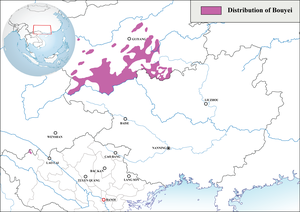Bouyei people
 A Bouyei woman in front of her house | |
| Regions with significant populations | |
|---|---|
| Languages | |
| Bouyei • Mandarin Chinese | |
| Religion | |
| Shigongism • Buddhism | |
| Related ethnic groups | |
| Zhuang |


The Bouyei (also spelled Puyi, Buyei and Buyi; self called: Buxqyaix, [puʔjai] or "Puzhong", "Burao", "Puman"; Chinese: 布依族; pinyin: Bùyīzú; Template:Lang-vi), otherwise known as the Zhongjia, are an ethnic group living in Southern Mainland China. Numbering 2.5 million, they are the 11th largest of the 56 ethnic groups officially recognized by the People's Republic of China. Despite the Chinese considering them a separate group, they consider themselves Zhuang (Tai peoples).[citation needed]
The Bouyei mostly live in Qianxinan and Qiannan prefectures of Southern Guizhou Province, as well as in Yunnan and Sichuan Provinces.
Some 3,000 Bouyei also live in Northern Vietnam, where they are one of that nation's 54 officially recognized ethnic groups. In Vietnam, they are known as the Bố Y and mostly live in Mường Khương District of Lào Cai and Quản Bạ District of Hà Giang Province.
Names
The Bouyei consist of various subgroups. Below are their autonyms written in the International Phonetic Alphabet with numerical Chao tones.[3]
- pu˦˨ ʔjɐi˦˨, 濮越
- pu˦˨ ʔji˨, 濮夷
- pu˦˨ noŋ˧˩, 布侬
- pu˦˨ loŋ˧˩, 补笼
- pu˦˨ na˧˩, 布那
- pu˦˨ tu˦˨, 布土、布都
- pu˦˨ ʔjaŋ˧, 布央
- pu˦˨ zoŋ˧˩xa˧˥, 布笼哈
Some clans within the Bouyei groups include:
- pu˦˨ wu˦˨, 布武
- pu˦˨ wei˧˩, 布韦
- pu˦˨ lo˨˦, 布鲁
In Congjiang County, Guizhou, there is a group that refer to themselves as "Buyeyi, 布也益", but are officially classified by the Chinese government as ethnic Zhuang.[4]
Distribution
In China by county
- County-level distribution of the Bouyei, from the 2000 Chinese census
(Only includes counties or county-equivalents containing >0.1% of China's Bouyei population.)
In Vietnam
- Province-level distribution of the Bố Y, from the 2009 Census
| Province | Bố Y Population | % of Vietnam's Bố Y Population |
|---|---|---|
| Lào Cai | 1,398 | 61.5% |
| Hà Giang | 808 | 35.5% |
| Other | 67 | 2.9% |
Language
The Bouyei speak the Bouyei language, which is very close to Standard Zhuang language. There is a dialect continuum between these two. The Bouyei language has its own written form which was created by linguists in the 1950s based on the Latin alphabet and with spelling conventions similar for the Pinyin system that had been devised to romanise Mandarin Chinese.
History
The Bouyei are the native Tai peoples of the plains of Guizhou. They are one of the oldest peoples of China, living in the area for more than 2,000 years. Prior to the establishment of the Tang dynasty, the Bouyei and Zhuang were linked together; the differences between both ethnic groups grew greater and from year 900 already they were two different groups. The Qing dynasty abolished the system of local heads and commanded in its place to officials of the army which caused a change in the local economy; from then on, the land was in the hands of a few landowners, which caused the population to revolt. During the Nanlong Rebellion of 1797, the Bouyei underwent a strong repression that caused many of them to emigrate to faraway Vietnam.
Culture
Many Bouyei are agricultural farmers who commonly cultivate crops for consumption or sale like rice, millet, wheat, potatoes, maize, cocoa, tea, silk and many other types of crops. The Bouyei have also played a major role as intermediate merchants in the region. Due to changing economies, the Bouyei engage in both small-scale and large-scale commercial or business operations.[5]
Traditional Bouyei handicrafts and batiks are renowned throughout the region. The Bouyei celebrate many festivals, both native and those derived from Han culture. One native festival is called the Ox King's Day, an annual celebration meant to honor oxen and their contribution to agricultural activities.[6]
Notable Bouyei people
- Guo Jian (郭健), artist
- Huang Xiaoyun (黃霄雲), singer and actress
- Wang Nangxian, leader of the anti-Manchu White Lotus Rebellion
- Xiao Sha (肖莎), gymnast
See also
References
- ^ "2-1 全国各民族分年龄、性别的人口" (XLS). Stats.gov.cn. Retrieved 31 August 2017.
- ^ "Report on Results of the 2019 Census". General Statistics Office of Vietnam. Retrieved 1 May 2020.
- ^ 贵州省志. 民族志 [Guizhou Province Gazetteer: Ethnic Gazetteer]. Guiyang: 贵州民族出版社 [Guizhou Nationalities Press]. 2002.
- ^ 回族, 白族, 瑤族, 壮族, 畲族, 毛南族, 仫佬族, 满族, 羌族卷. 贵州"六山六水"民族调查资料选编. 贵州民族出版社 [Guizhou Nationalities Press]. 2008. p. 291.
- ^ Olson, James Stuart (1998). An Ethnohistorical Dictionary of China. Greenwood Publishing Group. pp. 32–33. ISBN 978-0-313-28853-1.
- ^ Wu, Helen Xiaoyan (2009). "Culture of [the] Bouyei (Buyi)". Encyclopedia of contemporary Chinese culture. Routledge. pp. 46–47. ISBN 978-0-415-24129-8. OCLC 902156338.
- Yu, Cuirong (喻翠容) (1980). 布依语简志 [Introduction to the Buyi language]. Beijing: Publishing House of Minority Nationalities.
- Wu, Qilu (吴启禄) (2002). 布依汉词典 [Bouyei–Chinese dictionary]. Beijing: Publishing House of Minority Nationalities. ISBN 7-105-04965-0.
External links
- The Bouyei ethnic minority (government homepage, in English)
- Buxqyaix Qyusmail – 布依在线 (Bouyei online, in Bouyei and Chinese)
- 僚人全民概况 (Outline of the whole Liao [Rao, Lao, Tai] people)
- Bouyei language page (from Ethnologue site)
- 布依族网论坛[permanent dead link] (the forum of Bouyei, in Bouyei and Chinese, the biggest site of Bouyei in China)
- Map share of ethnic by county of China

